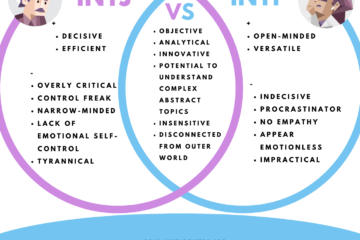Finally, the MBTI theory explained for all.
Understanding the MBTI personality theory can be quite daunting. The use of jargon makes it opaque. So, here is the ultimate MBTI theory explanation “for dummies”.
What are those letters all about? ENFP… INFJ… ESTJ… ISTP?
1.5 million people take the MBTI (Myers-Briggs Type Indicator) every year. What is the theory behind the success of this personality test? What does the test take into account? Finally understand what it means, without the use of jargon. We’ll mention some big words, but no need to remember them!
You might want to read our introduction to the MBTI right here. If you have no clue what we’re talking about.
In short, what is the MBTI theory about, again?
In a few words, the MBTI theory (or rather the Myers Briggs personality theory. Both appellations are used interchangeably… So I will do the same to keep it simple) explains how people make decisions and how they gather information.
It does so by defining different ways of making decisions and different ways of gathering information. These different “ways” of thinking are called functions in the jargon.
- 4 different ways to make decisions (known as judging functions).
- 4 different approaches to gathering information (known as perceiving functions).
The MBTI determines which ones are your 2 favorite decision-making processes and your 2 favorite approaches to gather information. Depending on the order you prefer to use them in, you are a certain Myers-Briggs personality type.
So, it doesn’t determine your personality per se. No one can tell you who you are, you special snowflake!
Now that you have a general idea, let’s see what ways to make decisions are taken into account by the MBTI theory, and on what criteria. Then, we’ll cover how one can gather information, according to the Myers Briggs personality theory.
The MBTI theory explains how you make decisions
To determine how you make your decisions, the MBTI assesses what criteria are important to you.
Why do we need to know that?
- If you know what criteria a person bases their decisions, you will have a better idea of how to communicate with them.
- You’ll know how to better convince them, as well. Always useful!
- Also, if you know what criteria are important to you, you’ll understand yourself and your life decisions better.
So what criteria does the Myers-Briggs theory use to define how people make their decisions?
What criteria do you use to make decisions?
"Objective" criteria vs. "subjective" criteria
Let’s use an example to explain this.
Example 1:
You’re annoyed. Your little brother never listens to you. You hate that disgusting pile of dishes in the sink. You tell him every day that he should do the dishes immediately after lunch because “he lives with other people” and “that’s what’s fair to do when you live in a community”.
What do we mean by "subjective criteria"?
What you’re doing there is:
- You’re trying to reason him with values, talking about “fairness”.
- You think that he should be more considerate of other people.
You’re using these arguments because that’s how you could be convinced to do the dishes.
In the Myers-Briggs theory, when someone prefers to use values or people as a criterion to make decisions, we consider that a “subjective“* way of making decisions.
There are two subjective decision-making functions in the MBTI called: introverted feeling and extraverted feeling. So it means that generally speaking when you make a decision you prioritize one of these two functions, in the jargon.
Everyone can use a subjective decision-making approach. The important factor is: Is it your favorite approach or are you better convinced by another type of criteria? Which type of criteria comes first when you need to decide?
What do we mean by "objective criteria"?
Now, your little brother might be a…
- Type of person who will consider “logic” before values.
- He does have values, but they’re not as much of a priority to him when it comes to decision-making, as they are to you.
People who prioritize “logic” and “facts” when making decisions use “objective” criteria. These more objective criteria are a sign that you prefer using one of the two objective decision-making functions. We call them introverted thinking or extraverted thinking.
If someone bases their decisions on objective criteria, the MBTI theory will explain this by saying they prefer using their thinking function over their feeling function.
IMPORTANT! The words “thinking” and “feeling” have specific definitions in the MBTI theory and in C.G. Jung’s work in analytical psychology. They do not mean “to think” and “to feel” as we usually intend. I will explain this further in a future article. So stay tuned!
The MBTI theory explains how to communicate with people who think differently
So, your brother won’t listen to you when you use “subjective” arguments because he makes his decisions based on “objective” arguments. Now, what you want to do is…
- adapt your speech to what is important to him. Tell him that if he doesn’t wash the dishes immediately, he’s going to have more work to do when the dirt has hardened and other people have piled up dishes on top.
- “More work” is an objective fact that your brother is prone to take into consideration. Great! He decides to finally wash the dishes! Wonderful!
This is a very basic example to make you understand the basics of the decision-making functions according to the Myers-Briggs theory. Now, you have an idea of how it can be used in everyday life. This example can be transposed to any situation at work, within your circle of friends, etc.
So, the MBTI theory explains how people either use subjective or objective criteria to make decisions. These different thinking processes suggest different personality “types”.
Why knowing your decision-making process is a good thing
Realizing that you are yourself more prone to taking into consideration subjective or objective criteria can…
- Help you understand why you make your decisions the way you do.
- Also, why other people, who are a different type than you, might not understand you for making decisions that way.
- It doesn’t mean that you’re wrong. It just means that you don’t consider the same things to be important.
Personally, when I found out that I was a subjective decision-maker and that my brother was an objective decision-maker (OMG there was some truth to example 1 !), it lifted a weight off my shoulders. Finally, I understood why he never listened to my arguments and why our communication was sometimes really poor. Now I know where it comes from and how we can work on it. It makes my life easier!
The Myers-Briggs theory reveals what kind of information you focus on
When we look around, we all see different things.
Hold on, even if we’re looking at the same exact thing? Well, our eyes might be seeing the same, but what do our brains do with this information? The MBTI theory puts words on the different styles of perception that exist.
If you know what people focus on when they look around (if you know what “perceiving functions” they use)…
- You will understand where they are coming from when they explain something to you.
- How they perceive the world explains their reaction to a situation.
- Knowing people’s favorite perceiving function can thus highly improve your understanding of people.
- And tell us how to communicate more effectively.
Gathering "concrete" information vs. "conceptual" information
Let’s use another example here to explain what perceiving functions are. Also, remember that everyone can use all functions, but the MBTI assesses the ones you set as a priority.
Example 2:
Jody is lost in the market. You call her and ask her what she sees in order to find her. Jody is precise. She tells you there are banana stands to her right and a tomato stand to her left. She’s been lost before; she knows it’s best to stay where she is and wait for you to come around.
Now, John is also lost and you call him and ask him the same questions. John tells you about the stand that reminds him of the old souk he saw in Tunisia. He passed it by a couple of minutes ago. John also tells you that it’s almost like a rock concert where he is. To find you he suggests you both meet where they sell pizza so that you can have lunch.
Gathering "concrete" information
We both know a Jody and a John. Jody perceives the world through her senses, like everybody else but…
- Her brain retains the information precisely, concretely, with details.
- She finds a solution through her own experience of the past.
When someone prefers to take away concrete information from their surroundings and solves problems by thinking of past experiences, it’s a sign that they are inclined to use what we call their “sensing” function in the jargon. There are two sensing functions called introverted sensing and extraverted sensing.
Gathering "conceptual" information
On the other hand, John’s not a very practical person, but we still love him dearly. So instead of telling you precisely where he is, he tells you about impressions, ideas that come to his mind when he looks around – which are not concrete details but rather abstract things. He says “It’s like a rock concert… It reminds me of a souk.”
John’s brain…
- changes the information he perceives with his five senses into ideas and impressions, rather than concrete facts and details, which he doesn’t pay attention to.
- His solution is oriented towards the future. Again, it’s not something concrete – not based on an experience, but rather a solution he’s imagined: “Let’s meet where we can have lunch later”.
When people focus on changing concrete information into abstract/conceptual ideas, they use the “intuition” functions. It is not “your guts” intuition, however. Intuition has its own meaning in analytical psychology and in the MBTI (so don’t take these words literally).
There are also two “intuition” functions: introverted intuition and extraverted intuition.
You’re starting to get the concept!
The impact of concrete vs. conceptual information
On the one hand, because of this difference in perception…
- People don’t understand the same things from the same situation or the same source of information
- In a conversation, their focus will be different (one concrete facts, the other on more abstract ideas)
- It often leads to a lack of comprehension and frustration between people
On the other hand, you can tell that there will be benefits in having, at work for instance, a team made out of a multitude of personality types. They will bring to the table different perspectives and different kinds of information which are all valuable. Hence, why professionals who work with people, such as recruiters and therapists, often use the MBTI.
We’ll tell you more about this in a future article. Subscribe at the bottom of this page if you want to get this kind of updates!
What about the meaning of the letters, then?
Remember how we talked about functions? Those thinking processes: “Feeling” “Thinking” “iNtuition“ “Sensing”. Well, the MBTI theory goes further and searches for the source of stimulation for each thinking process. Does the stimulation come from within? If yes, then it’s an “Introverted” function. Is the function more stimulated by external factors? If yes, then it’s an “Extroverted” function.
Putting the letters together: The Myers Briggs personality types are named after the functions they prefer to use, using a combination of the letters in bold shown above.
The first two letters indicate the way people perceive things.
Example: if someone uses Extraverted INtuition, they’re going to be an EN-type.
Are they a feeling type or a thinking type when it comes to their decision-making process? => Add the letter of the judging function next: EN-Fx.
If you are ready for a more advanced explanation, stay tuned and subscribe. We’ll tell you all about the “Ps” and the “Js” in a future article to keep things light, here.
So, you now have a better idea of the basic concepts used in the MBTI theory to explain the differences between “personality types”. Congrats! Tell the world, share this article if you found it useful.
There’s plenty of reasons to leave a comment below!
- Ask me a question about the MBTI – I’ll soon come up with more advanced explanations and other thoughts on the MBTI. So don’t forget to subscribe to Ennpey’s newsletter 🙂
- Tell me how the MBTI has impacted your life – I’m interested!



0 Comments